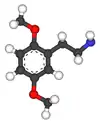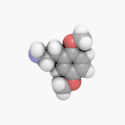2C-H
2C-H (2,5-dimethoxyphenethylamine) is a lesser-known substituted phenethylamine of the 2C family.
 | |||
| |||
| Names | |||
|---|---|---|---|
| IUPAC name
2-(2,5-Dimethoxyphenyl)ethanamine | |||
| Other names
2,5-Dimethoxy-phenethylamine | |||
| Identifiers | |||
3D model (JSmol) |
|||
| ChEMBL | |||
| ChemSpider | |||
| ECHA InfoCard | 100.153.556 | ||
PubChem CID |
|||
| UNII | |||
CompTox Dashboard (EPA) |
|||
| |||
| |||
| Properties | |||
| C10H15NO2 | |||
| Molar mass | 181.23 g/mol | ||
| Melting point | 138 to 139 °C (280 to 282 °F; 411 to 412 K) (hydrochloride) | ||
Except where otherwise noted, data are given for materials in their standard state (at 25 °C [77 °F], 100 kPa). | |||
| Infobox references | |||
History
2C-H was first synthesized in 1932 by Johannes S. Buck.[1]
Use
2C-H is used as a precursor in the synthesis of other substituted phenethylamines such as 2C-B, 2C-I, and 2C-N.[2] 2C-H has been found in trace amounts by the DEA's south central laboratory in tablets that were suspected of containing MDMA.
Pharmacology
There is no record of 2C-H trials in humans, as it would likely be destroyed by monoamine oxidase enzymes before causing any significant psychoactive effects.[2] In the book PiHKAL, Alexander Shulgin lists both the dosage and duration of 2C-H effects as unknown.[2] Very little data exists about the pharmacological properties, metabolism, and toxicity of 2C-H.
Research
2C-H exhibits agonist activity in vitro at human trace amine associated receptor 1 expressed in RD-HGA16 CHO-K1 cells coexpressed with Galpha16 protein assessed as internal calcium mobilization.[3] 2C-H was found to be inactive in NCI In Vivo Anticancer Drug Screens for tumor model L1210 Leukemia.[3] It was found to be an active Alpha-1 adrenergic receptor agonist in rabbit ear arteries.[3] It has binding affinity towards 5-HT2C and 5-HT2A receptors in rats.[3] It features competitive antagonist activity at 5-HT serotonin receptor in Sprague-Dawley rat stomachs.[3] It exhibits binding affinity against rat 5-hydroxytryptamine 2C receptors using [3H]mesulergine as a radioligand.[3]
Legal status
Canada
As of October 31, 2016; 2C-H is a controlled substance (Schedule III) in Canada.[4]
United States
As of July 9, 2012, 2C-H is a Schedule I controlled substance in the United States, under the Synthetic Drug Abuse Prevention Act of 2012.[5] 2C-H's DEA Drug Code is 7517.
References
- Buck, Johannes S. (1932). "Hydroxy- and Dihydroxyphenylethylmethylamines and their Ether". Journal of the Chemical Society. 54 (9): 3661–3665. doi:10.1021/ja01348a024.
- Shulgin, Alexander; Shulgin, Ann (September 1991). PiHKAL: A Chemical Love Story. Berkeley, California: Transform Press. ISBN 0-9630096-0-5. OCLC 25627628. 2C-H Entry in PiHKAL
- ""PubChem"".
- http://gazette.gc.ca/rp-pr/p2/2016/2016-05-04/html/sor-dors72-eng.php
- Portman. "Rules - 2013 - Establishment of Drug Codes for 26 Substances (SDAPA)". usdoj. Retrieved 22 July 2012.

